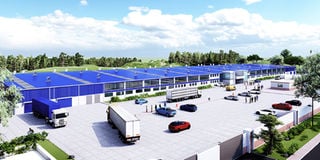The making of fit-for-purpose industrial space for apparel manufacturing in Kenya
Sponsored by Gatsby Africa

An impression of the kind of built spaces required to support Kenya's textile industry as the country intensifies its industrialisation agenda.
The East Africa textiles and apparel sector is on the cusp of change. In the next four to five years, Kenya has the potential to quadruple its annual garment exports into the US market to over $2 billion. This would bring with it 200,000 direct jobs, particularly for women, while also allowing Kenya to build her reputation as an environmentally and socially responsible destination for garment production.
Today, Kenya is already the leading exporter of garments under AGOA, recording $545 million worth of exports to the US market in 2023. Over 60,000 workers are directly employed in the country’s export-oriented zones, spread across 36 manufacturing factories. Dominating about 90 percent of the EAC apparel exports market to the US, investors from the UAE, China, India, Sri Lanka, Taiwan, and Kenya, have already recognised the region’s potential, and begun engaging in the sector.
As the US senate currently prepares to vote on the extension of the African Growth and Opportunity Act (AGOA) to 2041, which would extend Kenya’s duty-free access to US markets, Kenya is also engaging in bilateral talks with the USA under the Strategic Trade and Investment Partnership framework. This is expected to launch the first significant preferential trade relationship between the USA and a sub-Saharan country.
The opportunity is ripe. Investors are keen to access the market and are looking for ways to enter. The region’s young and educated population is ready to respond. However, standing between the sector’s potential and where it is today, are several constraints that continue to hold back the sector’s growth.
For the past three years, Gatsby Africa, a private foundation with 35 years of operating in East Africa, has been actively advocating for the development of fit-for-purpose industrial spaces. We have engaged with key players in the sector to understand the constraints they are facing, and how to best address them.
Built space
A lack of built space continues to hold the sector back. Potential garment manufacturers continue to visit Kenya, exploring our industrial parks and greenfield sites. Other investors have been offered access to generic existing warehouses that require significant modifications to make them suitable. Time and time again, the lack of existing infrastructure is proving expensive, costing potential investors a huge amount of time and money, leading them to explore investment opportunities in other countries. It is estimated that Kenya has already missed out on business from between 10-20 large investors, worth up to $200 million dollars, due to a lack of appropriate built space.
Compliance
To attract the right investment, built sheds need to be compliant and built to International Labour Organisation (ILO) standards, taking into consideration construction imperatives such as manufacturing area, height, spacing between the pillars, workflow considerations, toilet facilities, in addition to critical health and safety features such as emergency exists that include appropriate fire doors and firefighting equipment. Building on this, provisions for solar, water harvesting, canteens and day-care facilities could give Kenya further advantage.
To be successful, these changes need to be delivered at the right size and price, and garment manufacturers require an adequate production runway to scale and achieve commercial stability within the first few years of establishing the facility.
We are not starting from scratch. Kenya already hosts numerous global leading brands with sourcing and manufacturing hubs, office, and supply chains here. This serves as a testament to the country’s potential to emerge as the next global manufacturing hub for textile and apparel globally.
Opportunities for action
For the past three years, Gatsby Africa’s Textiles & Apparel programme has been working with developers and manufacturers to explore solutions to East Africa’s lack of built space.
The 2024 American Chamber of Commerce (AmCham) Business Summit held in Nairobi on April 24 and 25, focused on the steps that can be taken to realise this opportunity. To find out more, contact Joseph Nyagari via: [email protected]
Meanwhile, some investors have already taken the initiative and the emerging opportunity to establish fit-for-purpose built spaces in special economic zones being created across Kenya. Click here for a PDF copy of a newspaper supplement containing some of this information.


